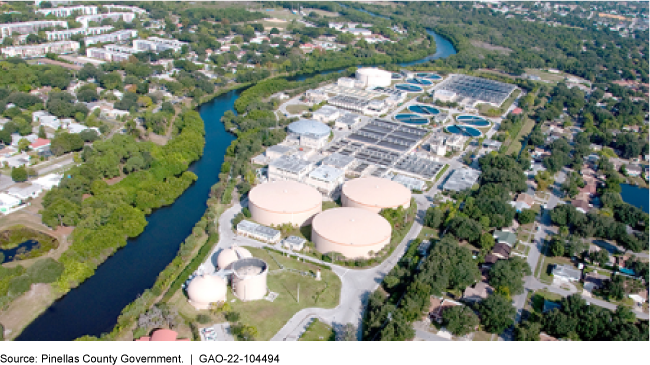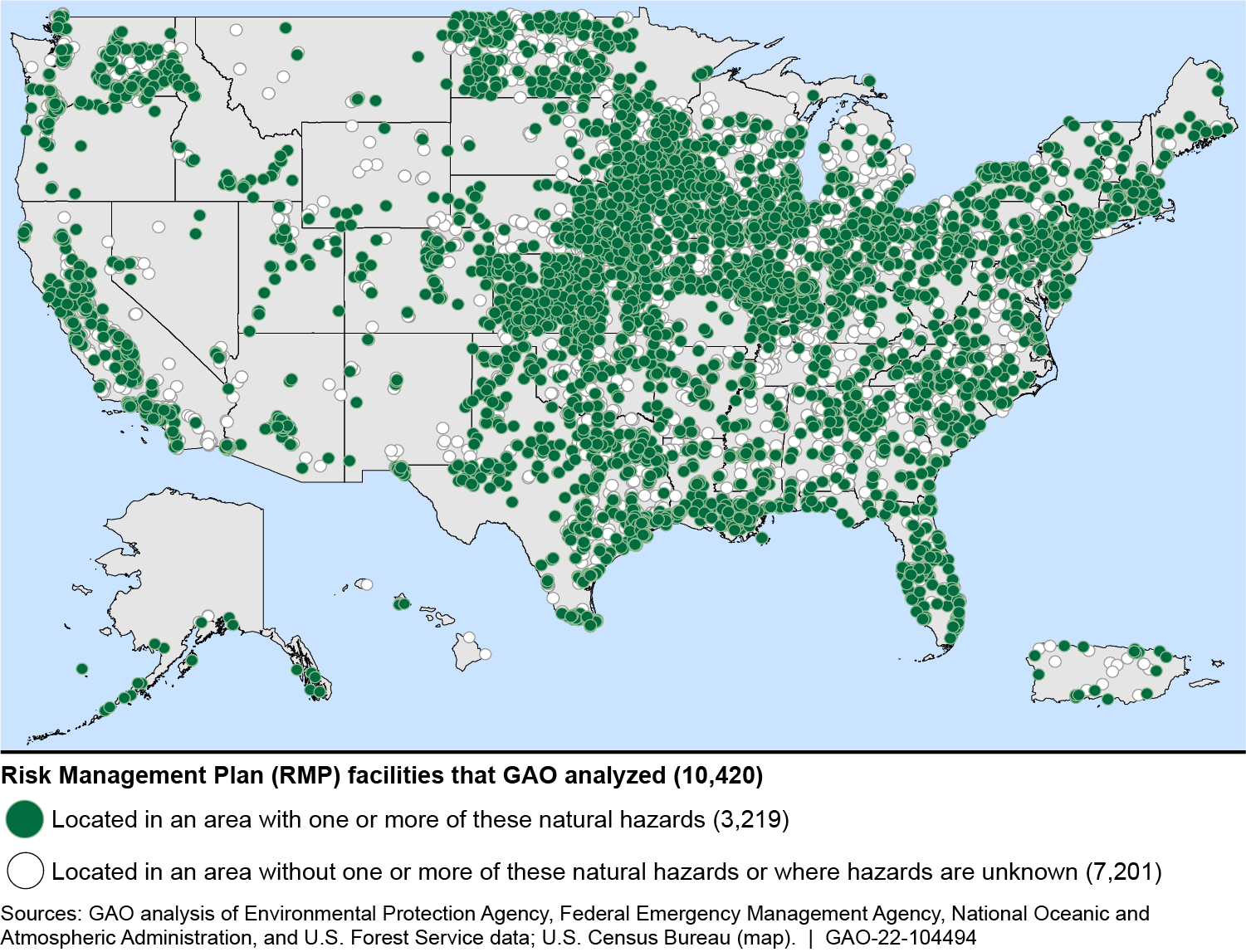Chemical Accident Prevention: EPA Should Ensure Regulated Facilities Consider Risks from Climate Change
Fast Facts
The EPA regulates certain facilities that make, use, or store hazardous chemicals. These facilities are required to have risk management programs to prevent and prepare for accidental releases of these chemicals.
Federal data indicates about 31% of these facilities are located in areas with certain natural hazards—like wildfires and storm surges—that may be worsened by climate change. We found that EPA doesn't consistently assess how these facilities are managing risks from natural hazards and climate change.
We recommended, among other things, that EPA provide more direction for facilities on including these risks in their programs.
The South Cross Bayou Advanced Water Reclamation Facility in Pinellas County, FL, works with the Local Emergency Response Committee to manage risks from potential flooding.

Highlights
What GAO Found
The Environmental Protection Agency’s Risk Management Plan (RMP) Rule requires certain facilities that make, use, handle, or store hazardous substances (chemicals) to develop and implement a risk management program to detect and prevent or minimize the consequences of an accidental release. These facilities, known as RMP facilities, include chemical manufacturers and water treatment plants. Federal data on flooding, storm surge, wildfire, and sea level rise—natural hazards that may be exacerbated by climate change—indicate that over 3,200 of the 10,420 facilities we analyzed, or about 31 percent, are located in areas with these natural hazards (see figure). View the full results of GAO’s analysis here.
RMP Facilities Located in Areas That May Be Impacted by Flooding, Storm Surge, Wildfire, or Sea Level Rise

Notes: This map does not include one RMP facility in each of Guam and the U.S. Virgin Islands, Storm surge data are not available for the West Coast and Pacific islands other than Hawaii, and sea level rise data are not available for Alaska.
RMP facilities face several challenges, including insufficient information and direction, in managing risks from natural hazards and climate change, according to some EPA officials and stakeholders. By issuing regulations, guidance, or both to clarify requirements and provide direction on how to incorporate these risks into risk management programs, EPA can better ensure that facilities are managing risks from all relevant hazards. When developing any such regulation, EPA should, pursuant to relevant executive orders, conduct a cost-benefit analysis.
Why GAO Did This Study
Over 11,000 RMP facilities across the nation have extremely hazardous chemicals in amounts that could harm people, property, or the environment if accidentally released. Risks to these facilities include those posed by natural hazards, which may damage the facilities and potentially release the chemicals into surrounding communities. Climate change may make some natural hazards more frequent or intense, according to the Fourth National Climate Assessment.
GAO was asked to review climate change risks at RMP facilities. This report examines, among other things, (1) what available federal data indicate about RMP facilities in areas with natural hazards that may be exacerbated by climate change; and (2) challenges RMP facilities face in managing risks from natural hazards and climate change, and opportunities for EPA to address these challenges. GAO analyzed federal data on RMP facilities and four natural hazards that may be exacerbated by climate change, reviewed agency documents, and interviewed agency officials and stakeholders, such as industry representatives.
Recommendations
GAO is making six recommendations, including that EPA issue regulations, guidance, or both to clarify requirements and provide direction to facilities on incorporating natural hazards and climate change into risk management programs. EPA agreed with our recommendations.
Recommendations for Executive Action
| Agency Affected | Recommendation | Status Sort descending |
|---|---|---|
| Environmental Protection Agency | The Assistant Administrator of the Office of Enforcement and Compliance Assurance and Director of the Office of Emergency Management, together with EPA officials at regional offices, should provide additional compliance assistance to RMP facilities related to risks from natural hazards and climate change. (Recommendation 1) |
Open
EPA agreed with this recommendation. In December 2022, EPA noted that progress on this recommendation is contingent on the final rule being published, so the agency does not expect to develop additional materials to assist regulated entities in complying with the updated RMP regulations until after the final rule is published, currently scheduled for December 2023.
|
| Environmental Protection Agency | The Assistant Administrator of the Office of Enforcement and Compliance Assurance should design an information system to track common deficiencies found during inspections, including any related to natural hazards and climate change, and use this information to target compliance assistance. (Recommendation 2) |
Open
EPA agreed with the goal of this recommendation. In Spring 2023, the agency reported that it had completed the written business process for identifying common deficiencies and had begun the implementation.
|
| Environmental Protection Agency | The Director of the Office of Emergency Management should issue regulations, guidance, or both, as appropriate, to clarify requirements and provide direction for RMP facilities on how to incorporate risks from natural hazards and climate change into their risk management programs. (Recommendation 3) |
Open
EPA agreed with this recommendation. The agency published a proposed rule in August 2022, which includes amendments that would explicitly require RMP facilities to consider the risks of external events such as natural hazards, including those caused by climate change. EPA expects to publish the final rule by December 2023.
|
| Environmental Protection Agency | The Assistant Administrator of the Office of Enforcement and Compliance Assurance and Director of the Office of Emergency Management should develop a method for inspectors to assess the sufficiency of RMP facilities' incorporation of risks from natural hazards and climate change into risk management programs and provide related guidance and training to inspectors. (Recommendation 4) |
Open
EPA agreed with this recommendation. The agency is working on a proposal to revise the RMP regulations and expects to complete the revisions by December 2023. After the final rule is published, the agency stated that it intends to incorporate methods and/or materials related to assessing the sufficiency of RMP facilities' incorporation of risks from natural hazards and climate change into the Risk Management Program Inspector Training course.
|
| Environmental Protection Agency | The Assistant Administrator of the Office of Enforcement and Compliance Assurance, working with officials at regional offices, should incorporate vulnerability of RMP facilities to natural hazards and climate change as criteria when selecting facilities for inspection. (Recommendation 5 |
Open
EPA agreed with this recommendation. The agency is working on a proposal to revise the RMP regulations and expects to complete the revisions by December 2023. The agency noted that it will look for opportunities to incorporate risks from climate change into the National Compliance Initiative goals and inspection selection criteria, as well as refine its approach after the final rule is published.
|
| Environmental Protection Agency | The Assistant Administrator of the Office of Enforcement and Compliance Assurance, working with EPA officials at regional offices, should incorporate the relative social vulnerability of communities that could be impacted by an accidental release when selecting RMP facilities for inspection. (Recommendation 6) |
Closed – Implemented
EPA agreed with this recommendation. EPA noted that it has begun incorporating environmental justice indicators into inspection targeting in 2022 and will further refine this process in future years. In addition, the Office of Enforcement and Compliance Assurance's National Program Guidance, Fiscal Years 2023-2024 states that EPA has added environmental justice data to the list of high-risk facilities, which are subject to RMP requirements. In a memorandum issued on April 30, 2022, EPA committed to increase the number of facility inspections in overburdened communities and plans to set new inspection goals once it has collected additional information about such inspections.
|
